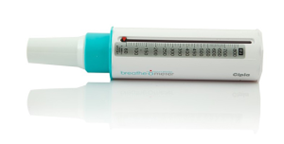Key Vitals to Track if You Have Asthma

Are you tired of letting asthma run the show? It’s time to take control! And here’s a simple way to do it.
Whilst asthma is a lifelong condition, most patient can control their symptoms with regular treatment and an action plan for self-management.1
Monitoring and working towards your vitals might allow more timely intervention for medical treatment, prevents you from requiring admission to the emergency department, and improves your quality of life.2
Here are some of the significant vitals every asthma patient should be tracking under the guidance of doctor:
- Peak Expiratory Flow Rate (PEFR) – By using a Peak Flow Meter PEFR measures the maximum amount of air that can be exhaled in one breath, providing a useful indicator of lung function. Normal test results are different for everyone based on their age, gender, and height.3
- Respiratory Rate - The number of breaths taken per minute can be a sign of whether asthma is under control or if an attack is imminent. The normal range for a healthy adult's breathing rate is between 12 and 18 breaths per minute.4 For asthmatics having an asthma attack, this range goes up to more than 30 breaths per minute.5
- SPO2 (Oxygen Saturation) - This measures the amount of oxygen in the blood using a pulse oximeter and can help determine if asthma is impacting breathing. The normal range for a healthy adult's blood oxygen saturation is between 95% and 100%, 6 but this range drops to 92% or lower for asthmatics having an attack.7
- Sleep - Monitoring your sleep patterns can be a helpful tool in managing asthma. Keep a lookout for night-time awakenings due to coughing or breathlessness and use this information to make changes and improve the quality of your sleep.8
In conclusion, tracking these key vitals can provide valuable insights into the management of asthma and can help individuals make informed decisions about their health.
Read more on breahefree.nepal.com.
References
- Pinnock H. Supported self-management for asthma. Breathe (Sheff). 2015;11(2):98-109. doi:10.1183/20734735.015614
- Gibson PG. Monitoring the patient with asthma: An evidence-based approach. J Allergy Clin Immunol. 2000;106(1):17-26. doi:10.1067/mai.2000.107949
- Determining a "Normal" Peak Flow. American Lung Association. https://www.lung.org/lung-health-diseases/lung-disease-lookup/asthma/treatment/devices/peak-flow
- Chourpiliadis C, Bhardwaj A. Physiology, Respiratory Rate. [Updated 2022 Sep 12]. In: StatPearls [Internet]. Treasure Island (FL): StatPearls Publishing; 2024 Jan-. Available from: https://www.ncbi.nlm.nih.gov/books/NBK537306/
- Papiris, Spyros, et al. "Clinical Review: Severe Asthma." Critical Care, vol. 6, no. 1, 2001, p. 30, https://doi.org/10.1186/cc1451
- Welsh, Emma J., and Robin Carr. "Pulse Oximeters to Self Monitor Oxygen Saturation Levels As Part of a Personalised Asthma Action Plan for People with Asthma." The Cochrane Database of Systematic Reviews, vol. 2015, no. 9, 2015, p. CD011584.
- Asthmatic oxygen levels: What to know. Medical News Today. https://www.medicalnewstoday.com/articles/asthmatic-oxygen-levels#summary.
- Xiang B, Hu M, Yu H, Zhang Y, Wang Q, Xue F. Highlighting the importance of healthy sleep patterns in the risk of adult asthma under the combined effects of genetic susceptibility: a large-scale prospective cohort study of 455 405 participants. BMJ Open Respir Res. 2023;10:e001535.
- Vital Signs. Cleveland Clinic. https://my.clevelandclinic.org/health/articles/10881-vital-signs.

